最新人教版七年级英语下册unit3(详细内容)
人教版七年级英语下册Unit3课件
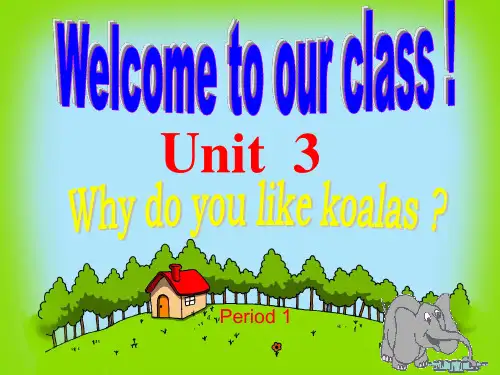
smart
fun
friendly beautiful
cute
clever
scary
cute
1b
Listen and check (√) the animals in 1a you hear.
Match the words with the animals in the picture.
1.tiger
swim fast play with a ball
What animal is it?
small interesting live in trees
like to eat leaves
be from Australia
What animal is it?
fat strong
come from Africa
kind
1) kind of 意为“有点儿,稍微”, 常用于口语,修饰形容词。 The monkey is kind of smart. 这只猴子有点可爱。 2)a kind of 意为“一种” This is a kind of pen. 这是一种笔。 Tiger is a kind of cat. 老虎是一种猫科动物。
2) let sb. do sth.让某人做某事 let sb not do sth 让某人不做某事
What animal is it?
shy big and fat black and white eat bamboo
be from China
What animal is it? cute clever live in the sea jump
Unit 3
Period 1
Now we are at the gate of the zoo. We can’t see any animals, but we can hear some of them. What animals can we hear? Listen and guess.
Unit3SectionA2d3c课件人教版七年级英语下册
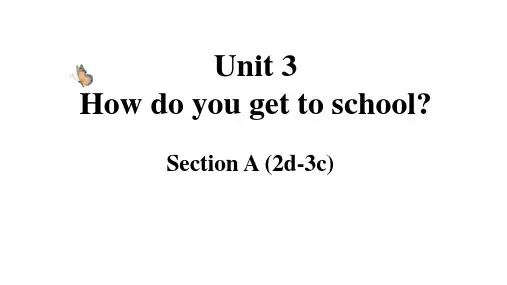
3a Read the story and answer the questions.
1.Why was Nancy’s mom angry with her?
Because Nancy didn’t want to take the dog for a walk.
2. Did they solve the problem? How?
7:00 - 7:25
6:40 - 7:25
How do you get to school? I …
How long does it take?
It takes …
How farΒιβλιοθήκη is it?It’s about …
拓展 how引导特殊疑问句的其他常见用法如下:
询问程度、 你认为北京怎么样? 看法 How do you like Beijing? 今天的天气怎么样?
Unit 3 How do you get to school?
Section A (2d-3c)
Review
Look at the pictures and make up sentences.
I go to _________ by _____. I take ________ to the _____.
How do you get to school? I ride my bike.
How does she get to school? She usually takes the bus.
How long does it take to get to school?
It takes about 15 minutes.
It takes about 15 minutes.
人教版七年级英语下册-Unit 3:知识点复习总结+单元测试(word版,含答案)
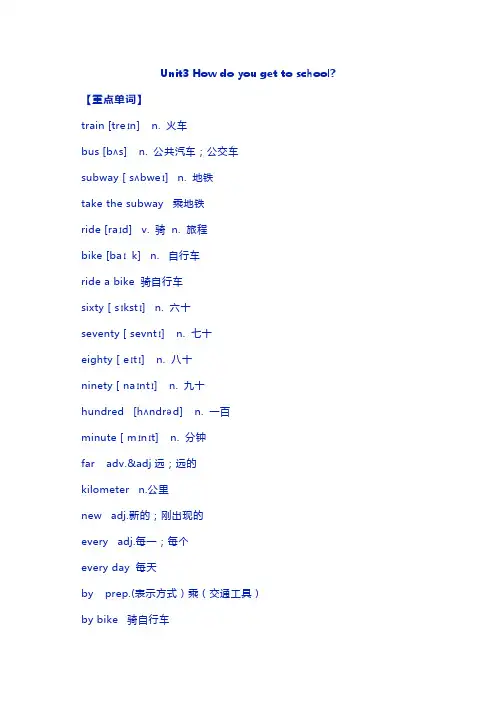
Unit3 How do you get to school?【重点单词】train [treɪn] n. 火车bus [bʌs] n. 公共汽车;公交车subway [ sʌbweɪ] n. 地铁take the subway 乘地铁ride [raɪd] v. 骑n. 旅程bike [baɪk] n. 自行车ride a bike 骑自行车sixty [ sɪkstɪ] n. 六十seventy [ sevntɪ] n. 七十eighty [ eɪtɪ] n. 八十ninety [ naɪntɪ] n. 九十hundred [hʌndrəd] n. 一百minute [ mɪnɪt] n. 分钟far adv.&adj远;远的kilometer n.公里new adj.新的;刚出现的every adj.每一;每个every day 每天by prep.(表示方式)乘(交通工具)by bike 骑自行车drive v.开车car n.小汽车;轿车live v.居住;生活stop n.车站;停止think of 认为cross v.横过;越过river n.河;江many adj.&pron.许多village n.村庄;村镇between prep.介于…之间between…and…在……和……之间bridge n.桥boat n.小船Ropeway n.索道year n.年;岁afraid adj.害怕;惧怕like prep.像;怎么样leave v.离开dream n.梦想;睡梦v.做梦true adj.真的;符合事实的come true 实现;成为现实【重点短语】1. get to school 到达学校2. take the train 乘火车3. take the subway 乘地铁4. ride a bike 骑自行车5. how do you get to school 怎么到达学校6. one hundred and five 1057. how far 多远8. how long 多长时间9. it takes sb some time to do sth 它花费某人多长时间做某事10. ride the bike to school 骑自行车到学校11. walk to , drive to ,fly to…步行去…;开车去…;坐飞机去….12. every day 每天13. I’m not sure 我不敢确信14. about= around 大约15. 10 kilometers 十公里16. good exercise 好的锻炼17. drive his car to work 开车去上班18. in his father’s car 坐父亲的车19. need about 10 minutes to get to school 需要十分钟的时间到达学校20. what do you think of…=how do you like…你觉得怎么样21. cross the river 过河22. It is easy to get to school. 到达学校很容易。
(完整word版)人教版七年级英语下册unit3(详细内容).docx
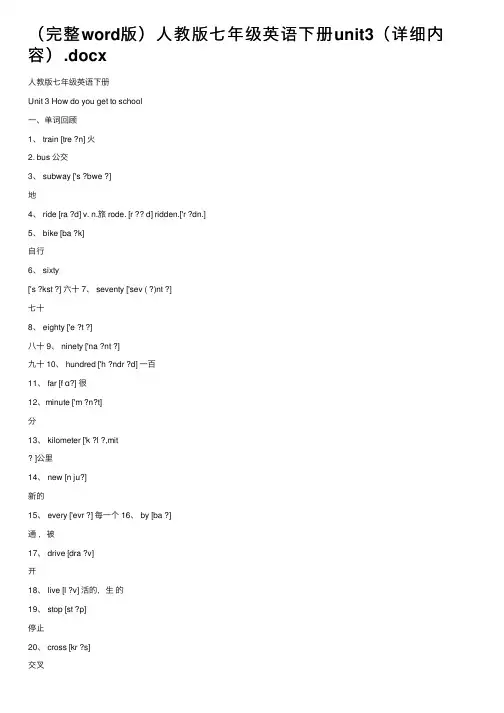
(完整word版)⼈教版七年级英语下册unit3(详细内容).docx⼈教版七年级英语下册Unit 3 How do you get to school⼀、单词回顾1、 train [tre ?n] ⽕2. bus 公交3、 subway ['s ?bwe ?]地4、 ride [ra ?d] v. n.旅 rode. [r ?? d] ridden.['r ?dn.]5、 bike [ba ?k]⾃⾏6、 sixty['s ?kst ?] 六⼗ 7、 seventy ['sev ( ?)nt ?]七⼗8、 eighty ['e ?t ?]⼋⼗ 9、 ninety ['na ?nt ?]九⼗ 10、 hundred ['h ?ndr ?d] ⼀百11、 far [f ɑ?] 很12、minute ['m ?n?t]分13、 kilometer ['k ?l ?,mit]公⾥14、 new [n ju?]新的15、 every ['evr ?] 每⼀个 16、 by [ba ?]通,被17、 drive [dra ?v]开18、 live [l ?v] 活的,⽣的19、 stop [st ?p]停⽌21、 river['r ?v?]河,江 22、 many ['men ?] 多23、 village [' v ?l?d ?]村庄,村民 24、 between[b ?'twi? n]介于?之25、 bridge [br ?d?]26、 boat [b ?? t] ⼩船27、 ropeway ['rop,we]n. 索道空中缆索 28、 year [j ??] n. 年;年度;29、 afraid [?'fre ?d] 害怕;惧怕30、 like [la ?k] 像;怎么(介)31、 leave [li? v] 离开; left ( lea ve 的过去式) 32、 dream [dri?m]梦想;睡梦33、 true [tru?] 真的;符合的⼆ . 词汇辨析: 1. take/spend/pay/costspend , cost , take 和 pay 都可以表⽰ “花 ”,但⽤法却不尽相同。
人教版新目标英语七年级下册Unit3知识点总结
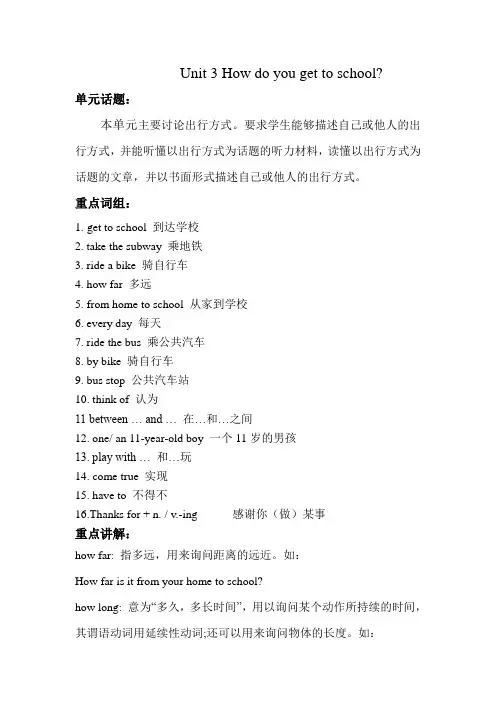
Unit 3 How do you get to school?单元话题:本单元主要讨论出行方式。
要求学生能够描述自己或他人的出行方式,并能听懂以出行方式为话题的听力材料,读懂以出行方式为话题的文章,并以书面形式描述自己或他人的出行方式。
重点词组:1.get to school 到达学校2. take the subway 乘地铁3. ride a bike 骑自行车4. how far 多远5. from home to school 从家到学校6. every day 每天7. ride the bus 乘公共汽车8. by bike 骑自行车9. bus stop 公共汽车站10. think of 认为11 between … and … 在…和…之间12. one/ an 11-year-old boy 一个11岁的男孩13. play with … 和…玩14. come true 实现15. have to 不得不16.Thanks for + n. / v.-ing 感谢你(做)某事重点讲解:how far: 指多远,用来询问距离的远近。
如:How far is it from your home to school?how long: 意为“多久,多长时间”,用以询问某个动作所持续的时间,其谓语动词用延续性动词;还可以用来询问物体的长度。
如:How long does it take you to get to school?between...and: 在……和……之间。
如:I sit between Tom and Helen. come true: 实现。
如:I think my dream can come true.重点句型:1. How do you get to school?2. How far is your from home to your school?3. But he is not afraid because he loves school.4. How long does it take you to get to school?这个句子中的take意为“花费”,一般指“花时间”,通常用于句型“It takes sb. some time(一段时间)to d o sth.”,意为“花费某人多长时间做某事”。
七下英语人教版第三单元笔记
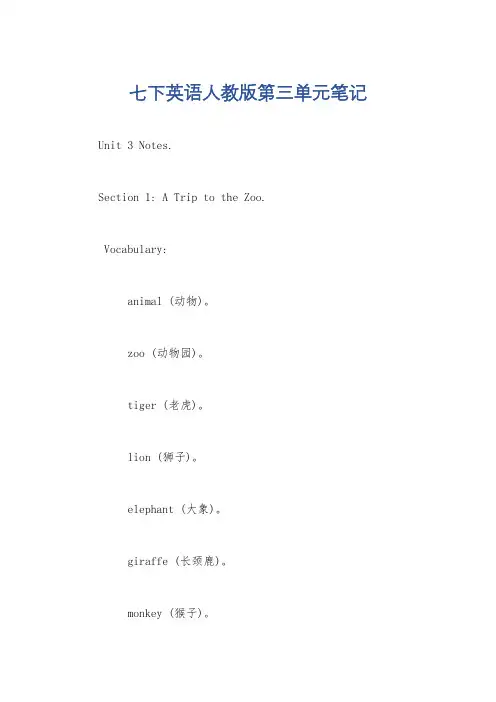
七下英语人教版第三单元笔记 Unit 3 Notes.Section 1: A Trip to the Zoo.Vocabulary:animal (动物)。
zoo (动物园)。
tiger (老虎)。
lion (狮子)。
elephant (大象)。
giraffe (长颈鹿)。
monkey (猴子)。
bird (鸟)。
fish (鱼)。
Grammar:Simple Present Tense (一般现在时)。
Present Continuous Tense (现在进行时)。
Section 2: Animals and Their Homes.Vocabulary:habitat (栖息地)。
forest (森林)。
grassland (草原)。
desert (沙漠)。
ocean (海洋)。
river (河流)。
lake (湖泊)。
Grammar:Prepositions of Place (方位介词)。
Section 3: Animal Behavior.Vocabulary:behavior (行为)。
instinct (本能)。
learned behavior (习得行为)。
communication (交流)。
migration (迁徙)。
Grammar:Modal Verbs (情态动词)。
Section 4: Animal Conservation.Vocabulary:conservation (保护)。
endangered species (濒危物种)。
habitat destruction (栖息地破坏)。
pollution (污染)。
poaching (偷猎)。
Grammar:Passive Voice (被动语态)。
中文回答:第一单元,动物园之旅。
词汇:动物(animal)。
动物园(zoo)。
老虎(tiger)。
狮子(lion)。
大象(elephant)。
长颈鹿(giraffe)。
期末复习人教版七年级英语下册unit3解析词汇、句型解析及练习(有参考解析)
期末复习人教版七年级英语下册unit3解析词汇、句型解析及练习Unit3 How do you get to school?01词汇讲解1. subway1)subway 在美式英语中意为“地铁”。
更常用“take the subway”或者“go by subway”表示“乘坐地铁”,而一般不用“take a subway”或者“go by a/the subway”。
例如:Let’s go by subway. 让我们乘地铁去吧。
You can take the subway to come to my house.你可以坐地铁来我家。
2)subway在英式英语中意为“地下通道”。
英式英语的“地铁”是“the underground”。
例如:We travelled across London on the underground.我们乘地铁穿过伦敦。
3)subway train 指“地铁列车”; subway station指“地铁站”。
例如:I’m on a subway train. I can’t hear you clearly.我在地铁上呢,听不清楚你说话。
It takes me 15munites to walk to the nearest subway station from my home.从我家步行到最近的地铁站需要15分钟。
2. ride1)ride 做名词时,意为“(乘坐汽车等的)旅行;乘骑;(乘车或骑车的)短途旅程”等。
常用于词组:go for a ride (去兜风) give sb. a ride (让……搭车)。
例如:Can you give me a ride to the market?你能让我搭车去市场吗?I’d like to go for a ride.我想出去兜兜风。
How much is a ride? 乘一次多少钱?2)ride做动词,意为“乘车,乘坐,搭乘”。
人教版七年级英语下册Unit3知识点
人教版七年级英语下册Unit3知识点重要单词:train 火车bus 公共汽车subway 地铁bike 自行车car 汽车minute 分钟kilometer 千米river 河village 村庄villager 村民bridge 桥boat 船year 年minute分钟stop停kilometer千米公里drive 开车live 居住cross 越过leave 离开形容词:new 新的every 每个afraid 害怕的true 真的介词:by 乘(交通工具)between 介于……之间ride v骑n旅程farmany 许多dream n梦想;睡梦v做梦重要短语:get to到达every day 每天think of 认为;想起come true 实现;成为现实between……and…… 在……和……之间1、表示交通方式take the train = by train 乘火车take the bus = by bus 乘公交车take the taxi = by taxi 乘出租车take the plane = by plane 乘飞机take the subway = by subway 乘地铁take a train = drive a car = by car 乘汽车/开汽车ride a bike = by bike 骑自行车2、It is + 形容词+ for sb to do sth 对于某人来说做某事怎么样It is important for us to study hard. 对于我们来说努力学习很重要。
It is easy for Tom to do his homework. 对于Tom来说做作业很容易。
3、every 每一;每个every day 每天every week 每周every month 每个月every year 每年every term 每学期He exercises every day. 他每天都锻炼。
人教版七年级英语下册Unit 3 整单元课件(共102张PPT)
How do American students get to school?
How do American students get to school?
?
How do American students get to school?
for handicapped(残疾的) students
Girl: He takes the bus.
Boy: How do Paul and Yang Lan get to
school?
小贴士:
Girl: They walk. Look, there 注th意e模y仿a以re“how”
now.
开头的特殊疑问句 的语调。
Have a try !
Sally bike
What’s the
way of traveling?
Means of transportation in the future
More comfortable 更舒适 More convenient 更便捷 Better for the environment 更环保 Better use of the energy 更节能
Let’s travel: May Day is coming !
Survey(调查)
How do you get to your favorite place?
Names How do you get to… ? Reasons (why)
Mrs. Xu by train
comfortable(舒适的)
How does she get to school?
Does she …? Yes, she does./ No, she doesn’t.
Unit3知识归纳人教版七年级英语下册
Unit 3 How do you get to school ?1.get to 到达2. take the train/subway/bus 乘火车/地铁/公共汽车3.ride a bike骑自行车4. how far 多远how long 多长;多长时间5.from.to.... 从...到....·6.every day.每天7. by bike/bus/train/subway骑自行车/乘公共汽车/乘火车/乘地铁8. have a good day 过得愉快9.walk to school步行去学校10.bus stop/station 公共汽车站11.think of 认为;想起12. bus ride 乘公共汽车(名词短语)13.drive his car 开他的车14. the school bus 校车15. between...and... 在...和...之间16. go on a ropeway 乘/坐索道;滑铁索17. cross the river 过河(动词短语)18. one/an 11yearold boy 一个11岁的男孩19. play with sb / sth 玩...., 和....玩耍20. e true 实现;成为现实21.be like 像....22. many of.. .....中的许多23. school day上学日/ on school days 在上学日用法集萃1.take+冠词+交通工具+to+某地=go to+某地+by+交通工具乘.....去.....2.be afraid to do sth. 害怕做某事,不敢做某事be afraid of ( doing) sth. 害怕(做)某事3.want to do sth. 想要做某事4.have to do sth. 不得不做某事5.How does sb. get to...?某人怎样到达.6.How far is it from...to...?从...到...有多远?7.It is + 距离+ (from A地to B地)从A地到B地有.....8.How long does it take ( sb.) to do..? 做.....花费(某人)多长时间?9.It takes (sb.) + 时间+ to do sth. 做某事花费(某人)一些时间。
- 1、下载文档前请自行甄别文档内容的完整性,平台不提供额外的编辑、内容补充、找答案等附加服务。
- 2、"仅部分预览"的文档,不可在线预览部分如存在完整性等问题,可反馈申请退款(可完整预览的文档不适用该条件!)。
- 3、如文档侵犯您的权益,请联系客服反馈,我们会尽快为您处理(人工客服工作时间:9:00-18:30)。
人教版七年级英语下册Unit 3 How do you get to school一、单词回顾1、train[treɪn]火车 2. bus 公交车3、subway ['sʌbweɪ]地铁4、ride[raɪd]v.骑n.旅rode. [rəʊd]ridden.['rɪdn.]5、bike [baɪk]自行车6、sixty['sɪkstɪ]六十7、seventy ['sev (ə)ntɪ]七十8、eighty ['eɪtɪ]八十9、ninety ['naɪntɪ]九十10、hundred ['hʌndrəd]一百11、far[fɑː]很12、minute['mɪnɪt]分钟13、kilometer['kɪlə,mitɚ]公里14、new [n juː]新的15、every ['evrɪ] 每一个16、by [baɪ] 通过,被17、drive [draɪv]开车18、live [lɪv] 活的,生动的19、stop [stɒp]停止20、cross [krɔs]交叉21、river ['rɪvə] 河,江22、many ['menɪ]许多23、village [' vɪlɪdʒ]村庄,村民24、between [bɪ'twiːn]介于…之间25、bridge[brɪdʒ]桥26、boat [bəʊt] 小船27、ropeway ['rop,we] n. 索道空中缆索28、year[jɪə]n. 年;年度;岁29、afraid[ə'freɪd]害怕;惧怕30、like [laɪk]像;怎么样(介词)31、leave [liː v]离开;left (lea ve的过去式)32、dream[driːm]梦想;睡梦33、true[truː]真的;符合实际的二. 词汇辨析:1. take/spend/pay/costspend,cost,take和pay都可以表示“花费”,但用法却不尽相同。
spend的主语必须是人,常用于以下结构:(1) spend time /money on sth. 在……上花费时间(金钱)。
例:I spent two hours on this maths problem. 这道数学题花了我两个小时。
(2) spend time /money (in) doing sth. 花费时间(金钱)做某事。
例:They spent two years (in) building this bridge. 造这座桥花了他们两年时间。
cost的主语是物或某种活动,还可以表示“值”,常见用法如下:(1)sth. costs (sb.) +金钱, 某物花了(某人)多少钱。
例:A new computer costs a lot of money. 买一台新电脑要花一大笔钱。
(2) (doing) sth. costs (sb.) +时间,某物(做某事)花了(某人)多少时间。
例:Remembering these new words cost him a lot of time. 他花了大量时间才记住了这些单词。
注意:cost的过去式及过去分词都是cost,并且不能用于被动句。
take后面常跟双宾语,常见用法有以下几种:(1) It takes sb. +时间+to do sth. 做某事花了某人多少时间。
例:It took them three years to build this road. 他们用了三年时间修完了这条路。
(2)doing sth. takes sb. +时间,做某事花了某人多少时间。
例:Repairing this car took him the whole afternoon. 他花了一下午修车。
pay的基本用法是:(1) pay (sb.) money for sth. 付钱(给某人)买……。
例:I have to pay them 20 pounds for this room each month. 我每个月要付20英磅的房租。
(2)pay for sth. 付……的钱。
例:I have to pay for the book lost. 我不得不赔丢失的书款。
(3)pay for sb. 替某人付钱。
例:Don't worry! I'll pay for you. 别担心,我会给你付钱的。
(4)pay sb. 付钱给某人。
例: They pay us every month. 他们每月给我们报酬。
(5)pay money back 还钱。
例:May I borrow 12 yuan from you? I'll pay it back next week. 你能借给我12块钱吗?下周还你。
即学即练:1) He often much time playing computer games.2) It usually her two hours to do her homework.3) How much did the new cell phone you?4) Allan 380 yuan for the e-dictionary.2. get to/ arrive in/arrive at/ reachreach后不用加介词如I reach school.get要加介词,但接副词时不用如THERE HOME HEREget to直接加地方arrive in/at也直接加地方,但IN 是大地方,AT是小地方reach,get,get to,arrive in/at都是及物动词,但arrive 不加介词时是不及物动词,可以不加宾语.如:I arrive 我到达了。
不能说I reach,/get/,get to,它们后面要加宾语。
即学即练:1)—When can you school? --I get to school at seven.2) They Beijing yesterday.3) They the bus stop.4) We home at six.3. other/others/the others/the other/another1.other可作形容词或代词,做形容词时,意思是“别的,其他”,泛指“其他的(人或物)”。
如:Do you have any other question(s)? 你还有其他问题吗?Ask some other people. 问问别人吧!Put it in your other hand. 把它放在你另一只手里。
2.the other指两个人或物中的一个时,只能用the other,不能用another,此时的other作代词。
如:He has two daughters. One is a nurse, the other is a worker. 他有两个女儿,一个是护士,另一个是工人。
the other后可加单数名词,也可加复数名词,此时的other作形容词。
如:On the other side of the street,there is a tall tree. 在街道的另一边,有一棵大树。
Mary is much taller than the other girls. 玛丽比其他的女孩高得多。
He lives on the other side of the river. 他住在河的对岸。
3.others是other的复数形式,泛指“另外几个”,“其余的”。
在句中可作主语、宾语。
如:Some of us like singing and dancing, others go in for sports. 我们一些人喜欢唱歌和跳舞,其余的从事体育活动。
Give me some others, please. 请给我别的东西吧!There are no others. 没有别的了。
4.the others意思是“其他东西,其余的人”。
特指某一范围内的“其他的(人或物)”。
是the other的复数形式。
如:Two boys will go to the zoo, and the others will stay at home. 两个男孩将去动物园,其余的留在家里。
.the others=.the other+可数名词复数5.another=an other,既可作形容词,也可作代词,只能用于三个或更多的人或物,泛指同类事物中的三者或三者以上的“另一个”,只能代替或修饰单数可数名词。
如:I don’t like this one. Please show me another. 我不喜欢这一个,请给我看看另一个。
I have three daughters. One is a nurse, another is a teacher and another is a worker.我有三个女儿。
一个是护士,另一个是教师,还有一个是工人即学即练:1) Lin Feng always help people.2) The old man has two sons. One is a soldier, is an engineer.3) Many people are in the park. Some are taking a walk, are flying kites.4)Would you like cup of coffee?4. a number of /the number ofa number of 是指“大量的”,后面的动词是复数形式e.g. A number of our classmates love English.the number of 是指“......的数量”,后面的动词是单数形式e.g. The number of our classmates is 45.1) A number of students reading in the classroom.2) The number of students in our class 56.四. 重点句:1. --How do you get to school?—I ride my bike.2. How far is it from your home to school?3. It takes me twenty-five minutes to school.4. That must be a lot more fun than taking a bus!5. What do you think of the transportation in your town?五. 重点语法:1. take的用法.一、拿,取I want to take some books to the classroom. 我想拿些书到教室。
